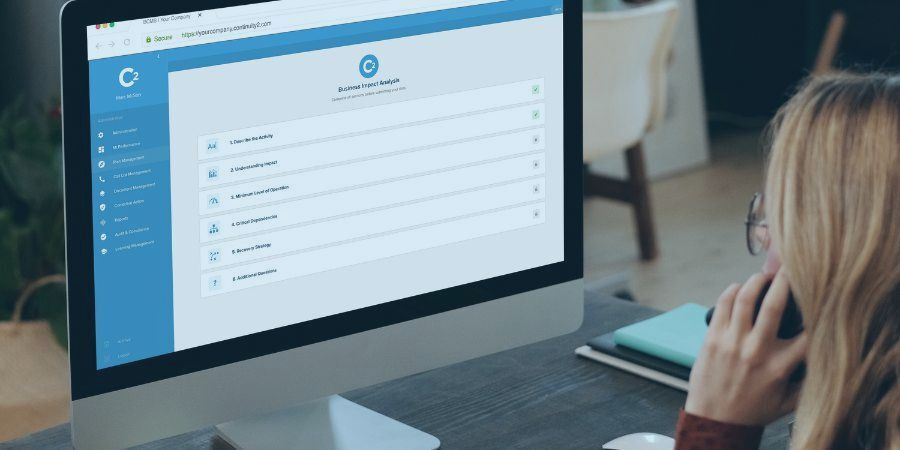Key Strategies for Enterprise Resilience
Published on December 20, 2023
Last updated on July 30, 2024
Jump to a section
Resilience in business is not just a buzzword, it's a necessity. Every enterprise, regardless of size or industry, faces a myriad of disruptions, from economic downturns to global pandemics. These challenges can shake the very foundation of your business, and only those equipped with robust resilience mechanisms can weather the storm and emerge stronger.
So, how can businesses cultivate such resilience? Discover the key aspects of enterprise resilience and how to thrive amidst challenges.
Key Takeaways
- The pillars of enterprise resilience are business continuity, crisis management and adaptability.
- Businesses can ensure customer access and safety by implementing safety software, creating digital experiences, and providing training to the support team on security & legal responsibilities.
- Fostering trust with investors through transparent communication is essential for long-term value creation & financial stability.
The Pillars of Enterprise Resilience

The backbone of enterprise resilience is made up of three interdependent elements: business continuity, crisis management and the capability to adapt. Recent occurrences such as the COVID-19 pandemic have presented organisations with a real test.
Having proper strategies for crises enabled them to cooperate better with government institutions and scientific experts, thus helping reduce its effect.
Businesses need to take proactive action like digitalizing processes via ICT tools coupled with ongoing education programs so that their ability to adjust quickly can increase to withstand future disruptions-which will become more frequent and serious over time.
Defining Enterprise Resilience
An enterprise’s resilience is its capacity to effectively manage, endure, and even overcome various difficulties or disruptions in supply chains that may be global.
It does not just refer to surviving but growing stronger despite difficult situations, much like a phoenix rises from ashes when given the right conditions for growth.
To ensure future adaptability against any potential disruption, enterprises have to build resilience to create a more robust future where they can prosper again after hardship passes by.
Business Continuity as a Keystone
Business continuity helps organizations remain stable during chaotic times. It is not solely focused on getting through the storm, but also protecting employees, which represents more than a third of resilience for companies in general.
When it comes to business continuity planning, you must develop an assessment of vulnerabilities and well-crafted plans with secure backup data options as well as thorough testing so everything runs smoothly if disruption were ever to occur.
This way, your business can benefit from having strong operational endurance while being able to act quickly with continual operations, reinforced by their continuous planning strategy implementations like enhancing security protocols and contingency procedures for backup data management.
Crisis Management Essentials
The focus of crisis management is to reduce disruption, lessen harm and encourage faith in customers. Primary facets of successful crisis management include strict health and safety practices like testing staff, tracing contacts, managing availability as well as alterations to work areas such as changes for cleanliness.
An example is the Nordic telecommunications firm, which formed a quick team when dealing with supply chain issues to limit damage efficiently. The implementation of effective steps was critical here since it alleviated potential problems considerably without any compromise on quality or service.
Crafting a Resilient Business Model

A business model serves as the foundation for a company’s operations and expansion. It can be resilient if it is flexible enough to adjust quickly and respond to new demands and challenges while creating long-term value.
This flexibility allows firms not just to maintain their competitive edge, but also to provide customers with exemplary service and capitalize on potential growth prospects, all of which help them overcome disturbances more easily.
Using a proactive approach that gives businesses better insight into a crisis helps reduce its short-term effects drastically.
Assessing and Adjusting Business Models
Resilient business models don’t simply come together overnight; they require ongoing evaluation and modification. Businesses must assess areas of improvement through surveys for customer insight, auditing their model, and gathering data from customers to build a bespoke strategy.
When faced with adversity, companies like Spotify, Unilever, and Cisco have shown an impressive level of adaptability by adjusting their operations accordingly. It has enabled them to remain strong despite obstacles thrown at them, showcasing why businesses must embrace change if they want maximum resilience within their business.
Incorporating Flexibility and Adaptability
Flexible business models that efficiently respond to new circumstances, market movements, and customer requirements are essential for survival in the ever-changing business environment.
Microsoft is the perfect example of this adaptive approach; they have been able to transition from a small enterprise into one worth billions, through their focus on data analysis and innovation.
Demonstrating its adaptability as a key factor in corporate success. Being open-minded towards fresh concepts coupled with changing strategies appropriately according to shifts within markets promotes companies’ abilities both now and in the future.
Long-Term Value Creation
You must prioritize long-term value creation to secure enterprise sustainability. It helps build trust and competitive advantage while managing risks simultaneously—all contributing towards an overall increase in total company value. Focusing on stakeholder interests enables companies to achieve stable profitability as well as supportive relationships between entities involved.
When constructing a corporate strategy directed at creating lasting benefits, decisions and investments must all have this end goal in mind. Efficient recording systems are essential here too for maintaining such details over a specified period - or longer if necessary.
Investing in personnel training could make certain employees more familiar with expected standards, while also enabling them to meet and exceed customer expectations when needed. Overall, these measures should support efforts made by businesses looking to acquire long-term growth success through effective value-generation methods employed.
Navigating Supply Chain Complexity

Supply chains, which provide the basis for businesses to function, often become intricate. Despite their complexity, navigating them is possible with effective planning and a focus on providing customers access through local supply channels. As seen during COVID-19 pandemic lockdowns, more emphasis was placed on e-commerce or home delivery systems.
Strategic preparation can ensure your business meets customer needs more efficiently. Ensuring accessibility remains key to preventing disruption of services due to any potential complexities within supply chain management processes.
Localizing Supply Chains
Organizations are highly dependent on supply chains for their operations. The longer these chains extend across borders, the more significant risks there can be in supplying necessary items like medical supplies and foodstuffs. Localizing such systems will lessen any concerns related to delivery timescales and enhance the security of deliveries.
In terms of expenditure savings relating to office real estate, companies should investigate providing intermittent meeting areas or remote work centers that offer key resources instead of having a physical presence in heavily populated locations which could be costly.
Ensuring Customer Access and Safety Capabilities
To ensure that customers remain at the centre of operations, even when disruption arises, a resilient enterprise needs measures for customer access and safety. To this end, it is necessary to introduce software solutions which aid in monitoring risk areas along with digital platforms for remote engagement with products or services.
Training should be provided about information security as well as legal obligations towards protecting customers’ welfare. All these steps will help businesses guarantee customer protection during challenging times and increase accessibility while strengthening their resilience overall.
Leveraging Technology for Enhanced Resilience

The development of digitalization, data-driven intelligence and information security have all become essential components in the building process to achieve a more resilient future for businesses. By leveraging these technologies, companies can strengthen their resilience and manage any disruption they might face while also gaining an edge against competition.
As such, technology serves as a powerful force to facilitate transformation and set enterprises on course towards creating an effective long-term sustainability strategy.
Digitalization and Data-Driven Intelligence
Data-driven intelligence has made a radical difference in the way businesses are managed. It provides insight and data that allow organizations to make educated decisions and react suitably to problems they encounter.
For example, digital transformation helps companies be more adaptive and expandable by hastening information sharing, enabling knowledge exchange, and facilitating flexible work processes.
Strengthening Information Security
The power of information in this digital age is undeniable. With that comes the obligation to ensure its security and prevent cyber risks like data compromises, operational obstacles or economic damage. To enhance protection over sensitive details and systems, implementing firewalls and intrusion prevention solutions along with antivirus software can be highly effective ways of doing so.
All these technological tools work together to improve info security inside a business setting while still preserving all original facts intact throughout the process.
Collaboration with Authorities and Markets
Business leaders are instrumental in developing strong collaborative relationships with policymakers and participating actively to influence policies and remain up-to-date about any changes. Such cooperation is essential for businesses that operate within a complex business environment.
Being aware of dynamic market conditions and relevant legislative regulations can help guide the necessary course corrections on their part.
Government Relations and Policy Insights
The introduction of government policies and regulations is crucial for the resilience of businesses. Companies should always thoroughly assess such changes to adapt their strategies accordingly.
Incorporating an approach centred on business resilience into government’s procedures is key to giving enterprises greater capacity when it comes to anticipating potential challenges and disruptions, as well as bouncing back from them efficiently.
Investor Risk Government and Market Dynamics
Risk management and capital markets also help businesses maintain financial security. By introducing strategies such as diversification, hedging or alternative investments with uncorrelated returns, companies can manage investor risk during volatile market conditions which in turn will improve the stability of their enterprise.
Employee-Centric Resilience Building
Building enterprise resilience begins with protecting the health and wellness of employees, as they are a critical component of any thriving business. Prioritizing human capital for building resilience must be at the forefront when returning staff safely post-pandemic by introducing adequate safety protocols and testing.

Scheduling Employees’ Physical Return and Health Measures
As employers return to the workplace post-pandemic, flexibility and precautionary measures are essential for creating a safe environment.
Ensuring employee safety both mentally and physically through protocols such as providing support services enable businesses to successfully transition back into the office space. Health and safety regulations should take precedence so that everyone feels confident and comfortable when returning to work.
This could include regulating hygiene practices along with offering psychological help if needed.
Human Capital as a Resilience Asset
Human capital is integral to the endurance of a business. The personnel’s aptitude, understanding, capacities and overall possibilities within an organization are vital in devising and upholding resilience.
By investing resources into employee learning, development opportunities and well-being policies, businesses can strengthen their capabilities as well as productivity, thus bolstering the enterprise’s durability.
Strategic Planning and Preparedness
Effective enterprise resilience starts with a well-planned strategy, including risk management. To fortify their ability to handle disruptions, companies must consider conducting stress tests and planning for various scenarios, as well as developing emergency preparedness plans.
This ensures that businesses are adequately equipped to tackle any risks associated with their operations in the long run.
Conducting Stress Tests and Scenario Planning
A stress test for a business is used to evaluate how it can maintain its performance in times of difficulty or tension. It involves gauging the effect that difficult yet realistic circumstances could have on an organization’s financial security, processes and general success.
Scenario planning allows firms to anticipate potential future issues and uncertainties while providing them with methods through which they can plan ahead accordingly.
Developing Emergency Preparedness Plans
Businesses must have a comprehensive emergency preparedness plan in place to respond effectively to any crisis.
Some of the crucial steps to achieve this involve conducting risk assessments, creating an operations team, setting up communication methods, establishing protocols and procedures specifically designed for emergencies, training employees accordingly, and testing & updating this plan when necessary.
By following those guidelines rigorously, companies can be sure they’re ready for whatever disruption that may come their way.

Financial Fortitude and Investor Relations
With external spending under control and being open with investors, businesses can guarantee their financial resilience. It is essential to maintain fiscal firmness for the business to be resilient and ready to face any challenges.
Streamlining External Spend
External spending management maintains financial stability in times of adversity. Businesses can take proactive steps, innovate and employ sensible cash flow methods to optimize their expenditure.
Transparent Communication with Investors
Investors desire transparency in communication and it is integral to keeping their trust. Strategies such as clear channels of information, regular updates, and maintaining consistency guarantee that investors will always have access to essential details for making informed financial decisions.
This type of openness facilitates honest dialogues between stakeholders while simultaneously boosting confidence levels within the relationship itself.
The Bottom Line
A resilience strategy is not a small project but requires thoughtful strategic commitment instead. This comprehensive approach must include the development of resilient business models and supply chain agility as well as taking advantage of technology along with creating relationships with regulators and other markets.
At its core, this effort for greater resilience also depends on valuing human capital (employees that fuel progress within an organization) to truly form a more robust future.
C2 Meridian is a comprehensive BCMS that helps your organization build resilience by planning for potential disasters more effectively. Request a demo today to see it in action and find out how we can help you streamline and protect your business operations.

Frequently Asked Questions
What is resilience in a business model?
Business resilience is a critical blend of risk management, including business continuity, disaster recovery and crisis management planning, that helps companies anticipate potential issues and promptly adapt to shifts in their environment. It requires the implementation of comprehensive measures for managing risks associated with such changes. To put it simply, business resilience allows firms protection against unexpected obstacles which can be detrimental if left unattended.
How can an enterprise attain resilience?
By providing the right resources and trusting employees to do their job effectively, businesses can increase resilience by establishing an Enterprise Resilience Framework. This should also include a flexible workforce as well as contingency plans for succession planning and disaster recovery efforts. All of which are critical in cultivating stronger resiliency overall.
Why is human capital considered a resilience asset?
Investing in the education and training of employees, often referred to as ‘human capital’, is an effective way for organizations to improve their resilience. Doing so increases employee proficiency and productivity while helping strengthen the enterprise’s ability to cope with any unexpected events or circumstances.
Written by Aimee Quinn
Resilience Manager at Continuity2
With an Honours degree in Risk Management from Glasgow Caledonian University and 6+ years in Business Risk and Resilience, Aimee looks after the design and implementation of Business Continuity Management Systems (BCMS) across all clients. From carrying out successful software deployments to achieving ISO 22301, Aimee helps make companies more resilient and their lives easier in the long run.


Written by Aimee Quinn
Resilience Manager at Continuity2
With an Honours degree in Risk Management from Glasgow Caledonian University and 6+ years in Business Risk and Resilience, Aimee looks after the design and implementation of Business Continuity Management Systems (BCMS) across all clients. From carrying out successful software deployments to achieving ISO 22301, Aimee helps make companies more resilient and their lives easier in the long run.